Summary of Philip Johnson
Philip Johnson's longevity (he died in 2005, aged 98) matches the extraordinary breadth of his influence on twentieth-century architecture. From his early days as a precocious, lonely Harvard student co-editing perhaps the most important book on modernist building, The International Style (1932), to the self-conscious classicism of his New York State Theatre (1964) and the postmodern bombast of his late skyscrapers, Johnson never failed to leave his mark on the cultural epochs he inhabited. A homosexual in an era of prejudice, and a political cynic - if not a reactionary - in an era of grand ideologies, he was an unpredictable, abrasive, and by all accounts memorable character. His legacy is in the skylines of Manhattan - and beyond that, in our conception of the metropolitan cityscape.
Accomplishments
- With the publication of The International Style in 1932, Johnson and his co-editor Henry-Russell Hitchcock defined a new paradigm in architecture that would hold sway for decades. What Johnson helped to identify, and what his own architectural practice reflected at the time, was a form of functional minimalism with its origins in the radical world-building of post-revolutionary Russia and the Bauhaus philosophy. Johnson realized this aesthetic could be - indeed, was being - applied all over the world, from Dhaka to Sao Pãulo, ushering in a new era of transnational modernism in building design.
- Johnson, perhaps more than any other figure, helped to separate modernist architecture from revolutionary politics. Modernism in architecture began in revolutionary Russia and the Bauhaus in Germany, and many of its leading figures were leftist or Marxist in their politics. But Johnson's International Style, based on modernist architecture, was not tied to any political agenda. For example, he was happy to apply International Style principles when constructing skyscrapers for New York capitalists. He also flirted with fascist politics during the 1930s-40s, indicating the extent to which he stripped the new architectural ideas from their original political connections.
- Later in his career, Johnson's work began to evolve beyond the modernism of his youth. With projects such as the New York State Theatre he introduced a kind of classicism, including a rectangular portico with columns in his design. In the 1980s-90s, the imposing yet decorative nature of his designs, such as the AT & T Tower (1994), saw him contribute to the new paradigm of postmodernism. As such, Johnson's significance to global architecture shifted with the times.
Important Art by Philip Johnson

Glass House
As its name suggests, Philip Johnson's landmark Glass House consists of one room made of a steel frame and glass walls. The flat roof contributes to the structure's overall box-like look and feel.
Arguably Johnson's most famous work, the Glass House was also one of his earliest creations, designed at the very start of his architectural career. It is the ultimate celebration of the modernist approach he admired, even worshipped, early on, its clearest inspiration being the work of Ludwig Mies van der Rohe, who had built a comparable glass house for a Berlin exhibition in 1931. Openly crediting Mies for his own building, Johnson began a long history of using other architect's ideas as the basis for his own designs. Of Mies's influence, Johnson later wrote: "the idea of a glass house comes from Mies van der Rohe. Mies had mentioned to me as early as 1945 how easy it would be to build a house entirely of large sheets of glass....My debt is therefore clear, in spite of obvious differences in composition and relation to the ground." Mies, however, was less than pleased with the application of his principles, and upon seeing the house with lights on famously described it as a "hot-dog stand."
In addition to the modernist exterior, Johnson filled the space, albeit sparsely, with modernist-designed furniture that included a simple rectangular bar to serve as kitchen counter space and a cabinet to separate his bed from the living room. The latter he filled with Mies-designed furniture. Chief Curator and Creative Director of the Glass House Hilary Lewis states that Johnson's idea for the house "was to bring modernism to the beauty of landscape." To do so, the house was located on a vast country estate which Johnson would populate over the years with fourteen other structures, including a guest house (1949), pavilion (1962), painting gallery (1965), sculpture gallery (1970), and library (1980). Well received among critics and the press, the house helped to launch Johnson's career and give him the beginning of the celebrity status he so desperately craved. Of this house, which he lived in periodically throughout his lifetime, Johnson once stated: "I consider my own house not so much a home (though it is that to me) as a clearinghouse of ideas which can filter down later, through my own work or that of others."
New Canaan, Connecticut

The Four Seasons
There are two main components to Philip Johnson's Four Seasons restaurant: a bar and grill room for more casual dining, and a formal dining room. The kitchen is discretely placed between the two rooms and hidden from the visitors. The dining room includes at its center a small pool made of white marble surrounded by four potted trees, a subtle yet clear reminder of the four seasons of each year.
In 1954 Philip Johnson received a prized early commission to work with his hero, Ludwig Mies van der Rohe, designing a large building in New York City, the Seagram building. While the working relationship was not easy, and for a period Mies van der Rohe was forced to return to Chicago to proceed with the project at a distance, this actually left Johnson more control over the project than originally anticipated. The result was a defining example of modernist architecture. This modernism was perhaps no better evident than in the design of the building's ground-level restaurant, the Four Seasons, over which Johnson had complete design control. In addition to the uniquely positioned marble pool, Johnson paid special attention to the interior aesthetic, adding panels of walnut and tiny ceiling lights that, along with gold-chain curtains, gave the effects of slight movement, as if one were watching the water gently rippling. Art was an important component of the design. The walkway between the two rooms contained a large mural by Pablo Picasso, and a metal rod-sculpture by Richard Lippold hung above the bar.
The restaurant, which won Johnson much acclaim, became an iconic New York location. The casual space, the Grill Room, became, according to author Mark Lamster, "an epicenter of American capitalism. It was here that the 'power lunch' was born, the term coined in a 1979 Esquire piece on the restaurant's ballet of wealthy and extremely wealthy patrons. Johnson cast himself among them, taking a prime corner table (number 32) that gave him an ample view of the proceedings - and potential clients." While no longer in existence (it moved from the Seagram building in 2016 and closed its doors in its new location in 2018), the Four Seasons remains a part of New York history and was memorialized in the 2009 play Red, which centered around the failed attempts to get artist Mark Rothko to create paintings for the restaurant.
New York, New York
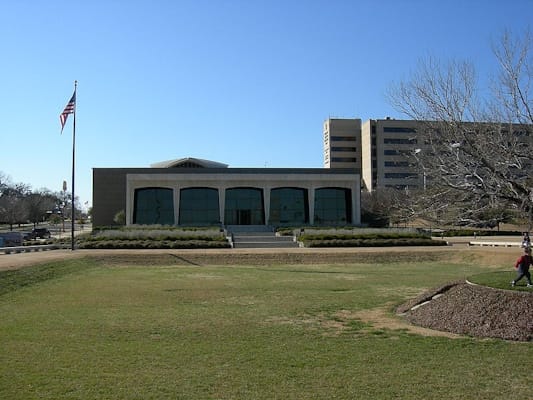
Amon Carter Museum
Philip Johnson's Amon Carter Museum is a decidedly understated design, featuring a simple, box-like structure. The front façade of the building includes a row of stark white columns which surround five large sections of glass.
This building is an important example of the series of museums Johnson was commissioned to create across his career. As it was a role at a museum (New York's Museum of Modern Art) which was the spur to his first architectural job, perhaps he felt a special affinity to these types of buildings.
This building marks an important transition to a new phase in Johnson's career. After years of modernist designs, in the 1960s he began to return to a more traditional approach, heavily influenced by classical architecture. This can be seen in the column design, reminiscent of Greek architecture. The classical aesthetic fits well with the original motivation for the building, to serve as a tribute to the benefactor of the museum, Amon Carter, and accounts for its monumental exterior façade. Interestingly, the interior still had a modernist feel, as author Mark Lamster describes: "whereas the exterior was decidedly antimodern, the interior was unapologetically Miesian, with exquisite materials - marble, brass, glass, steel - handled with great delicacy." The complexity of the design speaks to the larger paradoxes in Johnson's own career, and his embrace of many styles throughout his career.
Fort Worth, Texas
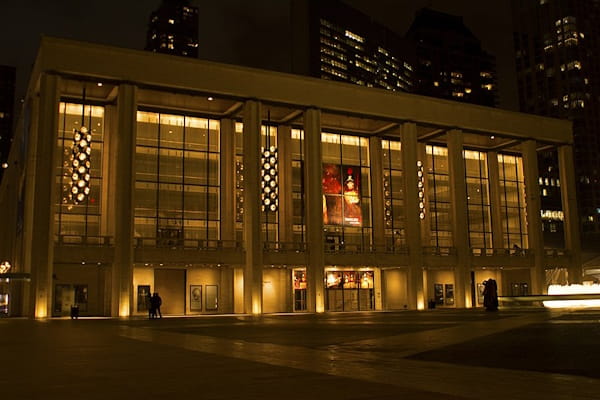
David H. Koch Theater (formerly New York State Theater)
An iconic New York City building, Philip Johnson's New York State Theater, now known as the David H. Koch Theater, is home to the New York City Ballet. Describing the building's container-like qualities, Stephen Fox notes that, "except for the glass curtain wall inset in the front portico, most of the rest of the building was windowless. The 2,729-seat theater was configured in an elliptical plan; continental seating was installed on the orchestra level. Above the orchestra were five balcony tiers....Generous public circulation spaces emanated from the fifty-foot-high Grand Promenade on the first tier level, one floor above the front entrance. The promenade was surrounded by walkways at the levels of the upper seating tiers, which were suspended from the roof structure on exposed steel cables."
Johnson had an innate ability to surround and ingratiate himself with wealthy and well-connected people. The commission for this career-defining building was due in large part to Johnson's amicable connection with the then-New York state governor, Nelson A. Rockefeller, who helped sponsor the project. Johnson was also friendly with Lincoln Kirstein, cofounder of the New York City Ballet. Once more taking inspiration from others, in this case the Paris Opera, Johnson was able to create a structure that allowed the audience to feel a part of the space. According to Lamster, a "sense of community was masterfully achieved in the theater's second-floor promenade, one of New York's great pubic rooms. Ascending to it from below was, like one of [choreographer George] Balanchine's ballets, an exercise in movement and drama. Patrons entering the building in the compressed space of the lobby were swept up a pair of grand staircases at either end of the room."
The building was designed at a time when Johnson was struggling to redefine his architectural aesthetic, moving away from modernism and the legacy of Ludwig Mies van der Rohe and towards a more traditionalist approach. According to Stephen Fox, this building "represented Johnson's boldest effort to invent modernist analogues to classical architectural and decorative conventions. It projected a social vision of the theater's audiences as glamourous urban elites whose public rituals occurred in a setting that assimilated the classical to the modern."
New York, New York
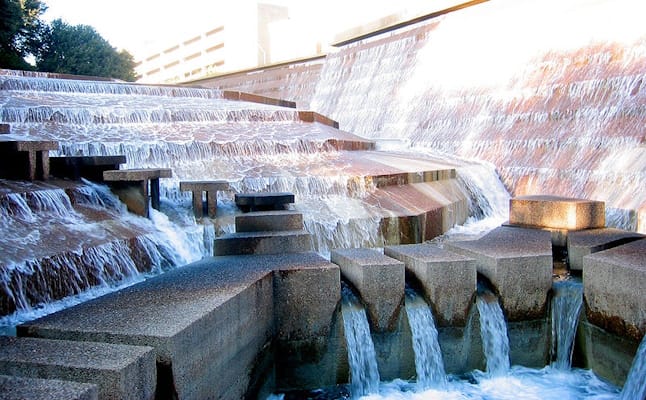
Fort Worth Water Gardens (Active Pool)
The Fort Worth Water Gardens included three separate but distinct areas of water. According to Lamster, the garden's aquatic component was "presented in a variety of states," including "a placid 'Quiet Pool,' set in a sheltered area surrounded by towering cypress trees, and an 'Aerating Pool,' from which forty dancing jets sprayed a cooling mist into the air. But the true centerpiece was the 'Active Pool,' a stepped, pentagonal well in which roaring whitewater crashed down nearly four stories before gurgling under a small platform."
This project provides an important example of one of Johnson's strong areas of interest, urban design. Part of a commission from the daughter of Amon Carter, for whom more than a decade ago Johnson had built a museum in tribute, his goal here was to create what Lamster calls "a grand urban amenity and linchpin for a revitalized downtown" in Fort Worth, Texas. As so often in his career, Johnson openly borrowed or based his design on the work of another. According to Lamster, in this case the environment was inspired by Lawrence Halprin's "terraced concrete forms and water features on the streets of Portland, Oregon."
The design was meant to be eye-catching and attention-grabbing, providing the viewer with a visual and physical adventure. At the Active Pool, Lamster notes, "daring visitors could visit this platform, and effectively stand in the midst of the waterfall, but to do so one had to traverse a path of table-shaped steps with no rails, and these were often slick from the spray of the falling water. Those who made the journey were in for a thrilling sensory experience, a combination of physical, aural, and visual pleasure. Johnson called this effect 'safe danger,' the idea being that it provided an adrenal rush with no genuine risk." While groundbreaking in its design and a good example of the diversity of projects Johnson completed throughout his career, this commission was riddled with issues. Tragically, the Active Pool became the site of four deaths on June 16, 2004. Lamster describes how, on that day, "three children and an adult who tried to rescue them were sucked underwater and drowned by the pool's recirculation pumps. A memorial plaque now pays tribute to their loss, and to prevent further deaths the pool's depth had been reduced to a level that is no longer lethal."
Fort Worth, Texas
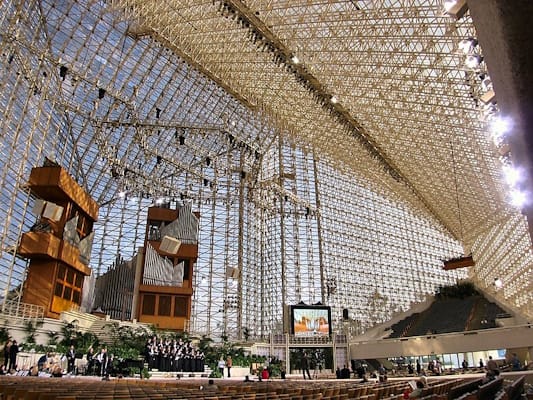
Crystal Cathedral
California's Crystal Cathedral is one of Johnson's most magnificent designs. Mark Lamster describes it as "an enormous box of reflective glass panels - 10,900 of them - in the shape of a flattened diamond, pinched in at the sides." He describes how "the building could be opened up with a 90-foot-tall door, inspired by NASA's hangar at Cape Canaveral, to allow...sermons to reach an overflow crowd in the parking lot. Inside the space was bright, cheerful, and orderly, with the altar facing the short axis, so the congregation (and the television audience) would feel close to the pastor."
Johnson was commissioned to design this building by the popular California-based evangelist Robert Schuller, who was looking to expand his existing church audience. The resulting structure was a celebration of modernism. Through the use of glass, Johnson completely revolutionized the idea of how a place of worship could be built. The spectacle of the church matched the large personality of the pastor, as well as that of Johnson. Willing to do anything to get the commission, according to Lamster, Johnson "did his best to feign piety in Schuller's presence, even allowing him to conduct prayers with the design staff when he visited the office."
The attention the architect received from the building made any controversy worth it from his point of view. The opening event provided Johnson with the kind of spectacle and focus on himself that he always craved, "a ceremonial event par excellence" Lamster notes, "with the Goodyear blimp overhead and a personal message from Ronald Regan." The design was also the source of much press attention, including New York Times critic Paul Goldberger's description of the work as, "if...not the deepest or the most profound religious building of our time,...at least among the most entertaining." This project was also marred by the kind of controversy Johnson was by now used to. Architect Eli Attia, who worked at his firm at the time, claimed the design was his. And it was not easy to dismiss this assertion, given Johnson's long history of borrowing ideas from the work of others.
Garden Grove, California
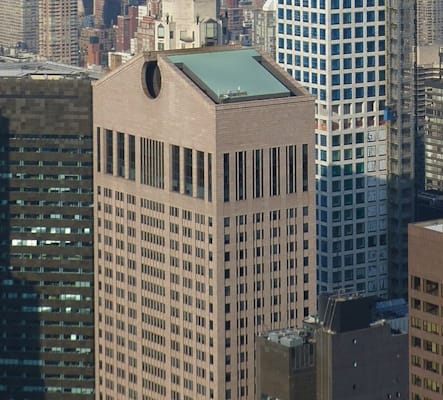
AT&T Tower
Philip Johnson's AT&T Tower (today known as the Sony Building) is a 37-storey, 647-foot skyscraper located in the heart of Manhattan on Madison Avenue. The impressive base of the building, according to author Stephen Fox is, "a colossal, sixty-foot-high loggia, 134 feet high at the central, vaulted entrance bay. The office floors, five through thirty-three, rose to a tall attic capped by a raked parapet split at its apex by a circular incision that earned the building the nickname of 'Chippendale skyscraper' for its likeness to eighteenth-century highboys."
An important building in Johnson's oeuvre, the AT&T Tower is a fine example of the many skyscrapers he designed during the last decades of his career. By creating such buildings he took on a key role in redefining the look and feel of American cities, but by all accounts he enjoyed the fame and prosperity his skyscraper commissions brought him as much as this cultural influence. Not everyone favored how this structure changed the urban landscape. According to Lamster, when asked years later by architect Rob Krier how he could "justify the building of skyscrapers," Johnson responded with typical brashness: "I am a whore and I am paid well for building high-rise buildings."
The AT&T Tower is arguably the quintessential example of Johnson's late, postmodern style. According to Lamster, the structure represents "an about-face from the firm's recent steel-and-glass designs, which had been interpreted as a development of the language of Mies [van der Rohe]....No building had made so distinctive a mark on the New York skyline since the early 1930s when the Empire State and Chrysler buildings had fought for aerial supremacy." According to New York Times critic Paul Goldberger, Johnson's 1994 monolith was the "first major monument of post-modernism." This shift was not well-received by all critics. For many this new style lacked any true originality. Writing for The Village Voice, critic and architect Michael Sorkin that "the so-called 'post-modern' styling in which AT&T has been tarted up is simply a graceless attempt to disguise what is really the same old building by cloaking it in this week's drag, and by trying to hide behind the reputations of the blameless dead." Regardless of its detractors, the design once more put Johnson at the head of architectural trends, where he always longed to be.
New York, New York
Biography of Philip Johnson
Childhood and Education
Philip Johnson was born into wealth in Cleveland, Ohio. His father, Homer Johnson, was an attorney and his mother, Louise Pope, came from a distinguished family including noted industrialists and philanthropists. He had two older siblings, Jeannette and Alfred (who died at age four), and a younger sister, Theodate. His childhood was not an overly pleasant one. Raised primarily by governesses, according to author Mark Lamster Johnson, Johnson spent his youth as "a prop in his parents' kabuki act of haut-bourgeois respectability. An obedient son, he was happy, or at least amenable, when asked to play his part in the family drama. And so he became a walking doll, photographed in a succession of dresses (at the tail end of acceptability for boys), Lord Fauntleroy outfits, knickerbockers, and sailor suits as ordered by his mother. The clothes changed, but he always wore the same affectless expression, ... he was not inclined to smile." What his father did pass along to his son from an early age was his strong anti-Semitic views, something that would influence Johnson, at least for a time, in his adult life.
School was equally difficult, partly due to a stutter that Johnson had until his high-school years. According to Lamster, "Philip was a loner at school. He ate his lunch by himself, and was reluctant to participate in sports and other group activities. The remoteness that had always been a part of his character, however, was metastasizing into a debilitating emotional affliction that would follow him throughout his early life." Illness also impacted Johnson during these years, first with the onset of the same ear disease, mastoiditis, that had taken his brother's life, and then through the development of bipolar disorder, which went undiagnosed for many years and further contributed to his feelings of isolation.
Early Training
Johnson was accepted to Harvard in the fall of 1923. There, his sense of isolation set in, accompanied by bouts of depression and mood swings. Of this time, Johnson would later state, "I was an outsider, and I felt it at the time." His lack of friends, however, may partly have been due to his arrogance towards others, which, according to Lamster, included his often walking around the campus with his roommate speaking only French. This attitude was furthered in the winter of 1924, when Johnson's father gave each of his children their share of their inheritance, making him a very wealthy eighteen-year-old who began to spend extravagantly.
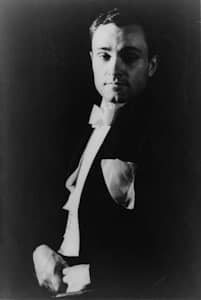
After suffering a nervous breakdown Johnson was forced to take a leave of absence from school. The start of his coming to terms with his homosexuality may have added to his anxieties. Eventually, his nerves recovered enough for him to return to school on a limited course-schedule, and it was then that he began taking architecture courses. He met fellow student Lincoln Kirstein and professors Alfred Barr and Henry-Russell Hitchcock, all of whom would impact his future career, helping to set him on his modernist path. Barr, for instance, told Johnson who he should meet and what buildings he should visit on a trip to Europe, which helped to expose him to the great Bauhaus architects. Across various overseas trips he would eventually interact with all of the field's giants, including Le Corbusier, Walter Gropius, J.J.P. Oud, and Ludwig Mies van der Rohe.
Mature Period
An important early event in Johnson's career was a book-project he worked on with Hitchcock about modernist architects. Their publication, The International Style, became a key text on modernist architecture, helping to define and establish a global movement of the same name. Johnson's first real mark in the field, however, was owed to Barr, who got him a job along with Hitchcock planning an exhibition about modern architecture at his new Museum of Modern Art in New York City. Bringing the show Modern Architecture to fruition in 1932 was not without its challenges, due largely to Johnson's personality, which caused him to butt heads with architect Frank Lloyd Wright, who would only stay in the show if Johnson agreed to include something he had written in the exhibition's materials. The show's ultimate success led to Johnson's promotion to chairman of the museum's department of architecture.
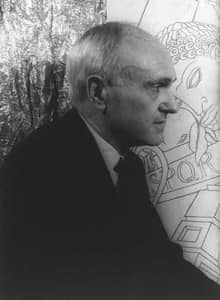
While traveling to Europe in the summer of 1932 to prepare for his next exhibition, Johnson got swept up in the rising tide of Nazism in Germany, attending his first Hitler Youth rally in October. Friends including Barr become concerned with the direction of Johnson's politics. Indeed, despite his growing recognition in his field, his political interests overtook all else for the next several years, during which he tried to build a nationalist party in the United States incorporating many of the ideas he had embraced in Europe, including Nazism. This led him to associate with controversial figures connected to the US populism of the day, including Lawrence Dennis, Huey Long, and Father Charles Coughlin. For the latter Johnson designed a large rally platform in 1936 in the International Style. The architect travelled to Europe again later in the decade, writing articles for fascist magazine The Examiner, attending a rally to hear Adolf Hitler speak, and reportedly meeting several Nazi officials. Johnson's activities led the FBI to open a file on him, and many believed he may have been working as a spy for the German government. According to Lamster, "when interviewed in 1942, Johnson's former secretary Ruth Merrill told the FBI that Johnson believed 'the fate of the country' rested on his shoulders, and that 'he wanted to be the 'Hitler' in the United States.'"
At the height of the Second World War, as opportunities at home including at his beloved MoMA dwindled due to his controversial actions and views, Johnson began to distance himself from his prior political statements. Trying to reinvent himself, he decided to enroll in Harvard's architecture school in 1940. Then, just as he earned his degree in spring of 1943, he was drafted into the army at the age of 37. Concerns over his possible allegiances to Germany prevented him from getting good assignments, and he was instead forced to do menial work for the duration of the war. In fact, despite various attempts to distance himself from this past, in the coming years it would haunt him, in no small part due to his own contradictory and often inflammatory statements, including in a letter in 1964 where he wrote: "personally I think the Nazis were better than Roosevelt, but I haven't had time to dig up the truth."
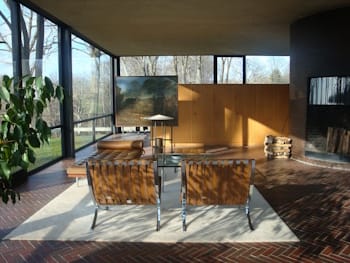
After the war, Johnson established an office in New York City, and was eventually able to get back onto the staff of MoMA as Consultant to the Department of Architecture. In 1947 he curated a major exhibition of the work of his hero Ludwig Mies van der Rohe, his hero. Not long after, in March 1948, Johnson began building his iconic work, the Glass House, on his property in New Canaan, Connecticut. The positive reception and press for this work led to more important commissions, many for influential figures, including the Rockefeller family. A promotion to Director of MoMA's Architecture Department followed, but once more Johnson proved difficult to work with. According to his curator Peter Blake - not to be confused with the British Pop Artist of the same name - "he could be arrogant, insulting, cutting, bitchy, devastatingly nasty - and he was often all of those things. But he was never boring." He became well-known for fallings out, grudges, and recriminations.
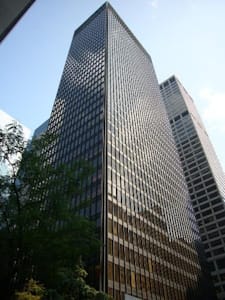
A series of mainly residential and interior design projects dominated the first third of Johnson's career. It was also, however, during this period that he received a rare corporate commission designing the Seagram Building (1958) in New York City in a secondary role to Ludwig Mies van der Rohe. Importantly, while the building was a Mies design, the Four Seasons restaurant in the building's ground floor was completely Johnson's design.
The second phase of Johnson's career could be seen to have begun in the late 1950s, and was marked by a move away from the modernist aesthetic and International Style he had helped to champion. Wanting to return to a more traditional approach, what he referred to as "structural classicism," his most famous work of the period was the design for the New York State Theater (now known as the David H. Koch Theater) (1964) at the Lincoln Center. This project led to his style sometimes being referred to as the "ballet school" because of the ballets performed there.
As some of these new traditional designs were less well received, Johnson shifted his focus once more, this time to urban design and planning. Having secured a coveted spot on New York City mayor John Lindsay's Task Force on Urban Design, Johnson focused on the redesign of the city's waterfront (something that would not be accomplished until years later, and without his oversight). Interested also in preservation, he teamed up with former first lady Jacqueline Kennedy Onassis to lead a "Committee to Save Grand Central Station" in 1975. Their friendship would be destroyed years later, once again due to his contrarian nature, when he pulled out of a book deal on which he was working with friend Rosamond Berneir. Onassis was serving as his editor at Doubleday when, without informing her, Johnson abruptly left for a new publisher. According to Lamster, Onassis was furious and instructed Bernier that neither of them would have any further communications with him.
Later Period
The final part of Johnson's career was primarily spent building skyscrapers and corporate buildings. This phase can be seen to have begun when, in 1967, Johnson took on John Burgee. The younger architect skillfully landed many of these commissions, many of which were completed in a postmodern style, including AT&T Tower (1994) in New York, an important late work for Johnson.
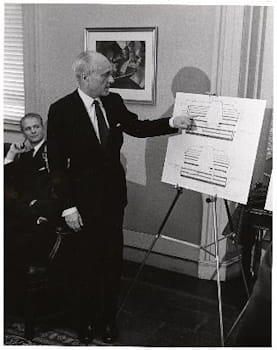
Despite his growing success, controversy continued to trouble Johnson during the last decades of his life. He was angry when MoMA did not select him as the architect for their new expansion project and refused to give the museum any further gifts from his impressive art collection. Johnson's health also began to fade and he would go through two heart surgeries, the first in 1972 and another in 1986.
Johnson also suffered professionally, struggling to maintain the stability of his architectural practice, the Philip Johnson Firm, which he ran since 1946. Burgee came to resent his role as secondary to Johnson in the firm they shared, and even Johnson's agreement to change the name of the company to "John Burgee Architects, Philip Johnson Consultant" was not enough to satisfy the younger figure. In the end, Burgee publicly forced Johnson out of the business, after which it ironically declared bankruptcy, Burgee having taken on all financial responsibility for its survival. Unscathed, Johnson started a new firm, but his declining health decreased his presence in the office.
Johnson spent most of his final years at his beloved Glass House and estate in New Canaan, with his partner of nearly four decades David Whitney. Johnson died quietly at the age of ninety-eight. Of his death, Lamster wrote: "Johnson had ordered there be no great obsequies, no grand memorial service. The man who courted attention and publicity his entire life wanted none that he could not experience himself. His end was a private affair. 'Death is nothing, you see - it just happens and that's the end,' he said."
The Legacy of Philip Johnson
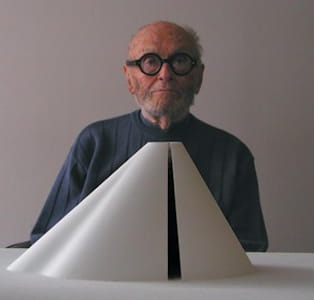
Philip Johnson had a profound impact on the field of architecture. He lived through and effected the two major ages of twentieth-century architecture, loosely categorized as modernism and postmodernism. In particular, he played a leading role in the spread of modernist architecture both through his early designs and through the articulation of what his hugely influential 1932 dubbed The International Style. Also, through the legacy of his skyscrapers, Johnson helped to reimagine what a city landscape could be, as well as predicting the look of postmodernist architecture. Author Mark Lamster writes that "the legacy he did leave extends beyond his architecture into art, design, and urban affairs....The architect of aesthetically modest modern residences of the mid-century became the designer of aesthetically bombastic postmodern towers as that same century came to a close. In between there were moments of enduring civility and dignity offset by works that were overblown, nihilistic, and crass."
Johnson's designs and visions have even made their mark on contemporary culture. His Glass House, for instance, created early in his career, broke down any sense of barriers on what a house could be for future generations in a way that still resonates. It can be argued, for example, that the contemporary "tiny-house movement" is possible in part due to the risks Johnson took with his Glass House concept.
Johnson's legacy also extends to the art world. Beginning early in his life during his trips to Europe, Johnson displayed a keen and intuitive eye in art-collecting, notably purchasing works by Paul Klee, Aristide Maillol, and Pablo Picasso. The large collection he amassed not only led to substantial gains to the MoMA's collection via gifts but also impacted his architectural designs. He often incorporated artworks into building projects, including in his design for the Four Seasons, in which artworks were a key part of the overall design aesthetic.
Influences and Connections

-
![Le Corbusier]() Le Corbusier
Le Corbusier -
![Walter Gropius]() Walter Gropius
Walter Gropius - John Burgee
- Henry-Russell Hitchcock
- Lincoln Kirstein
-
![Alfred H. Barr, Jr.]() Alfred H. Barr, Jr.
Alfred H. Barr, Jr. - Gerald Hines
- Dominique and Jean de Menil
- Blanchette Rockefeller
- Nelson Rockefeller
-
![Peter Blake]() Peter Blake
Peter Blake - John Burgee
- Michael Graves
- Henry-Russell Hitchcock
- Lincoln Kirstein
-
![Alfred H. Barr, Jr.]() Alfred H. Barr, Jr.
Alfred H. Barr, Jr. - Gerald Hines
- Dominique and Jean de Menil
- Blanchette Rockefeller
- Nelson Rockefeller
Useful Resources on Philip Johnson
- Philip Johnson: Life and WorkBy Franz Schulze
- The Man in the Glass House: Philip Johnson, Architect of the Modern CenturyBy Mark Lamster
 Ask The Art Story AI
Ask The Art Story AI











